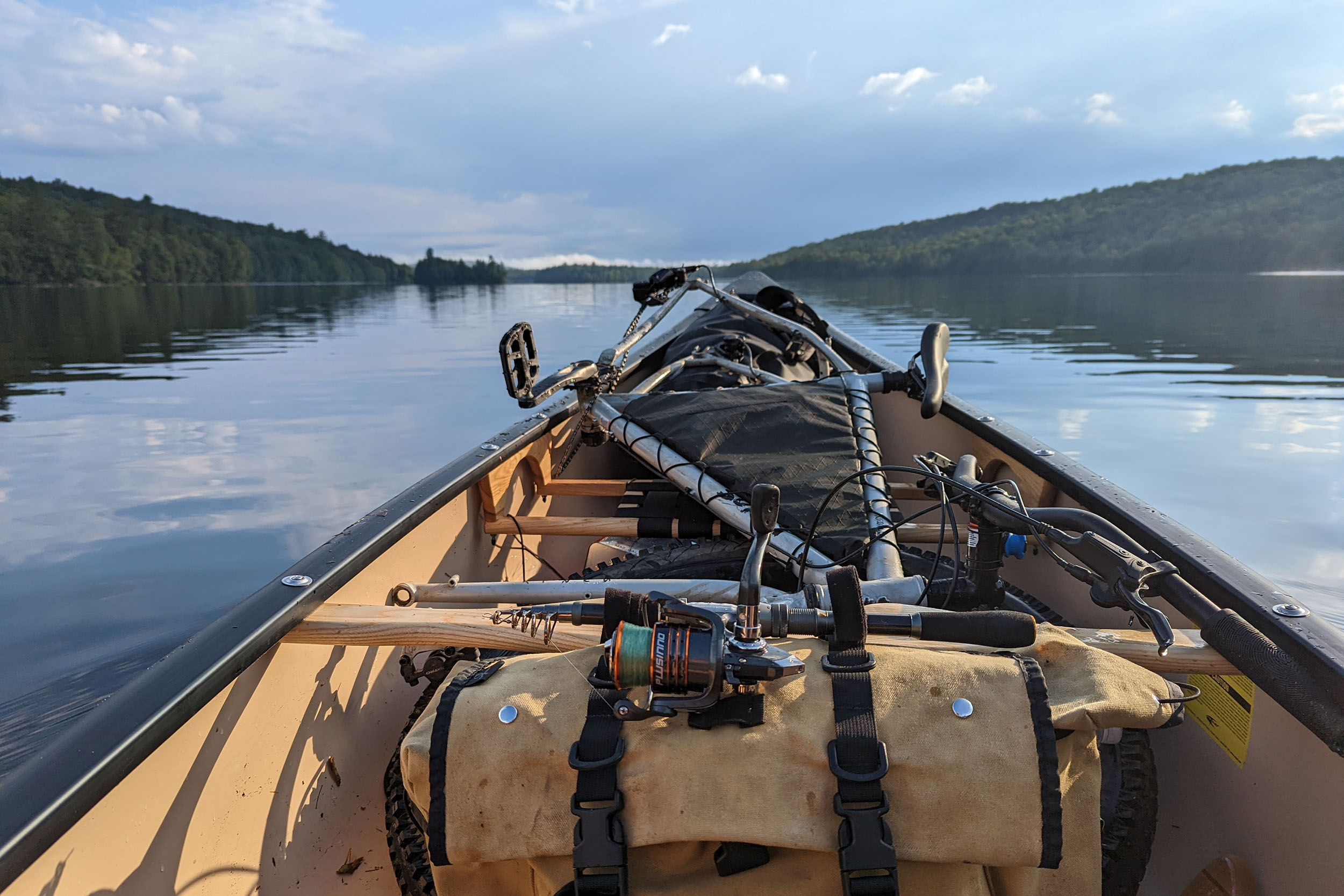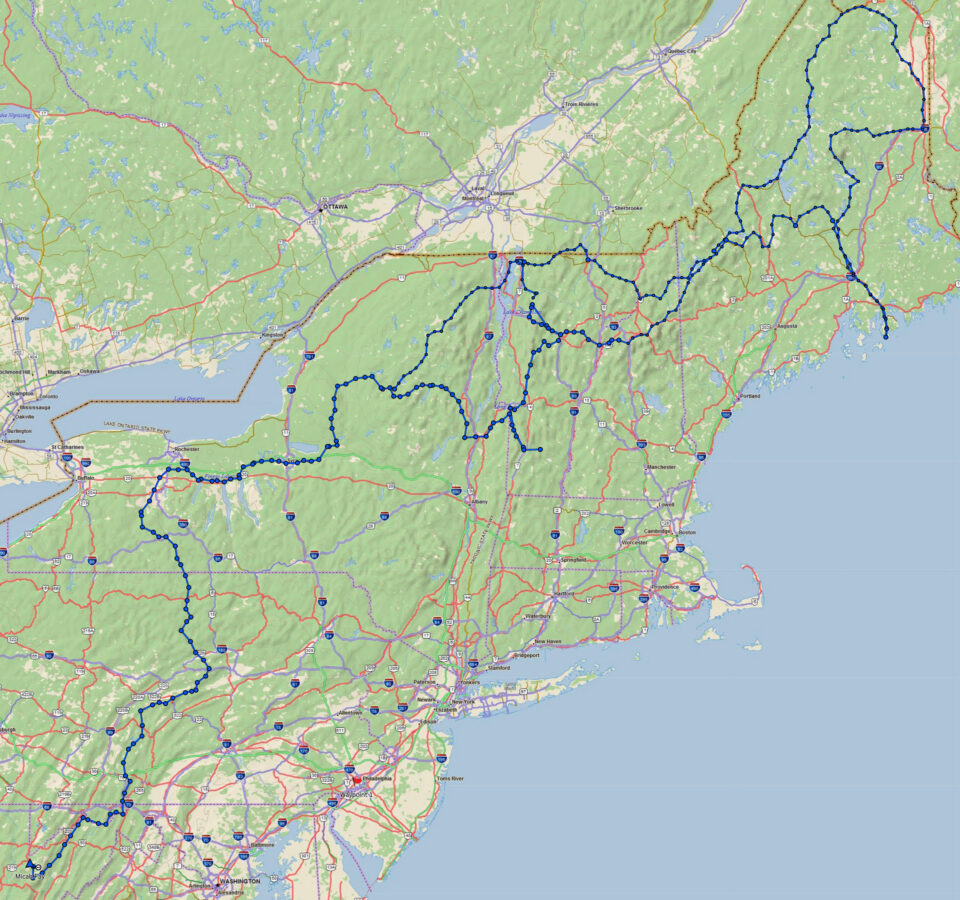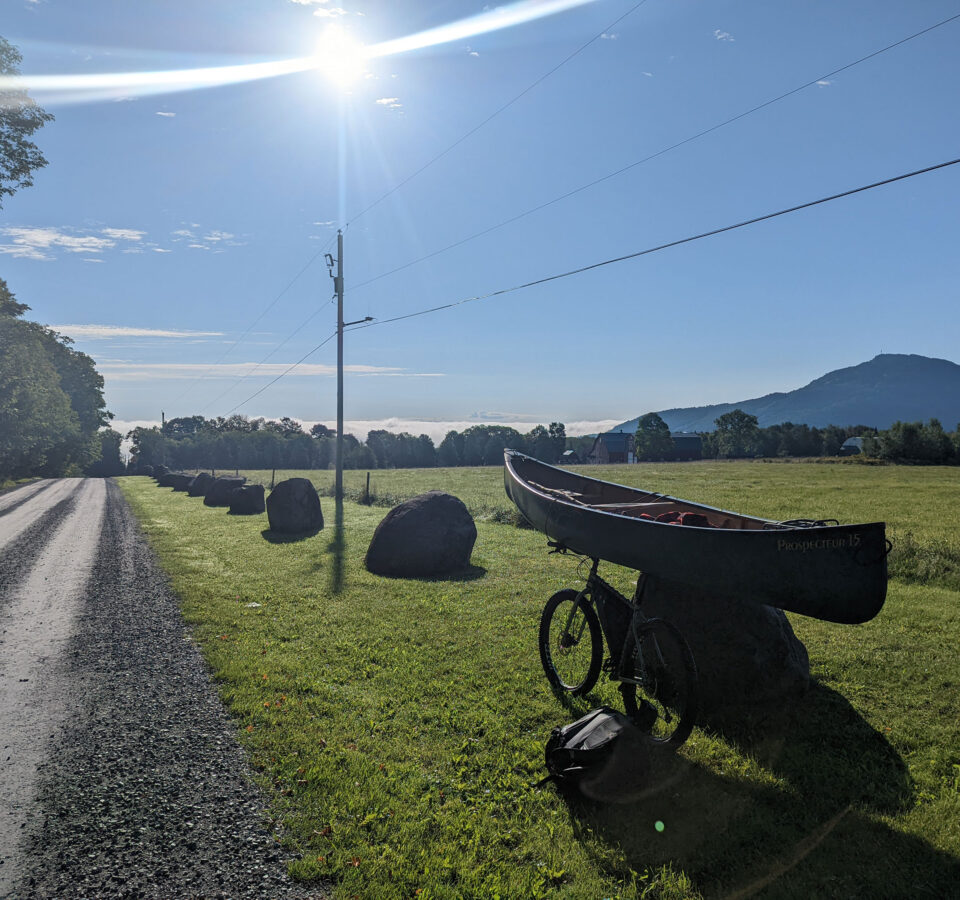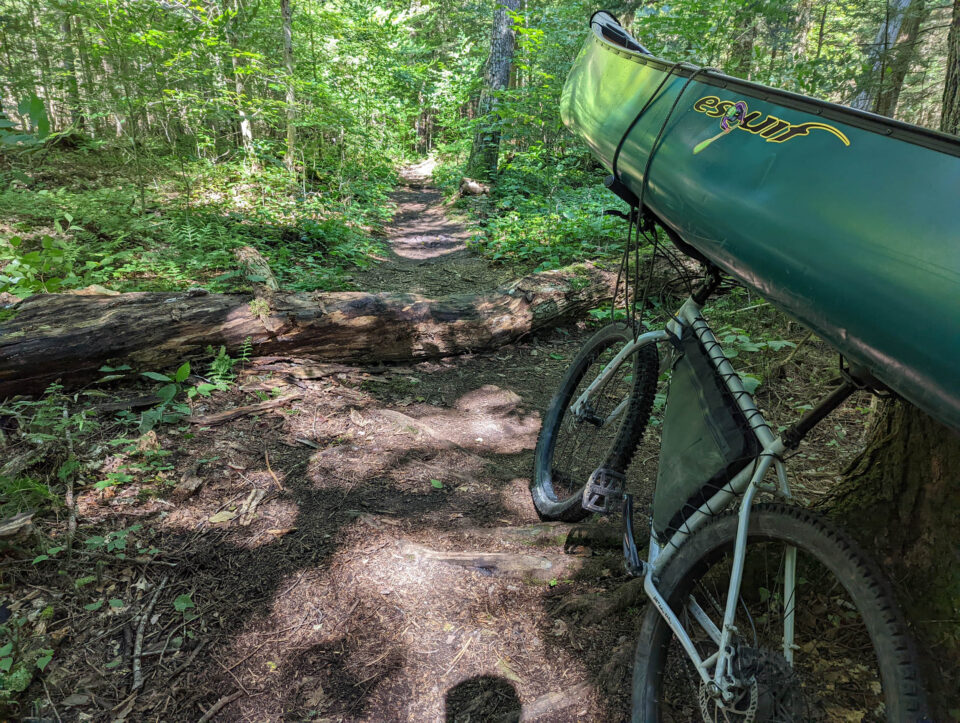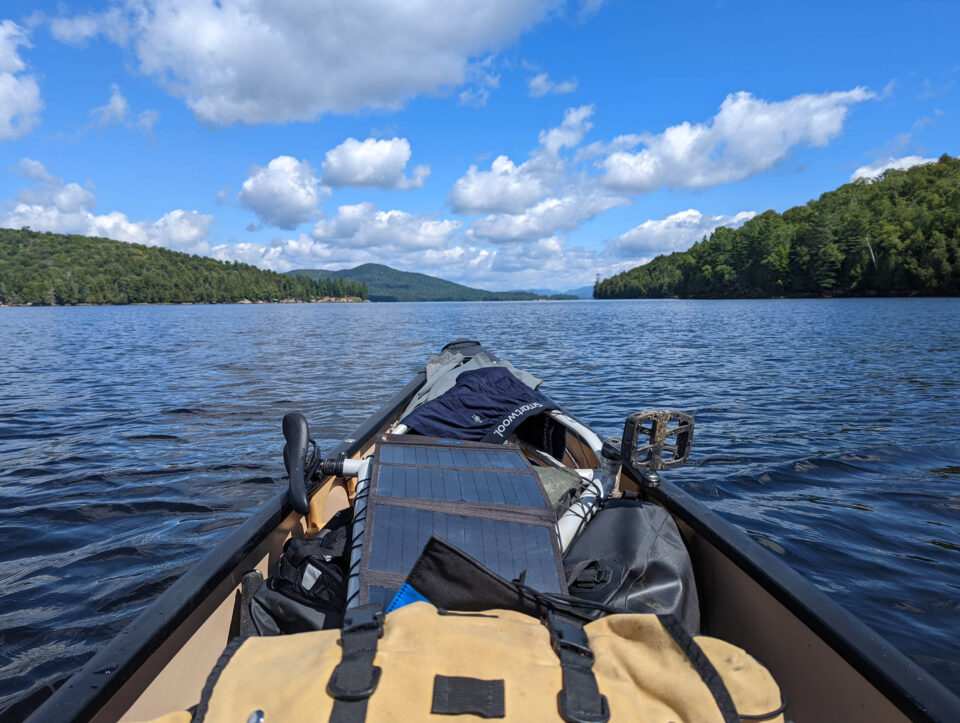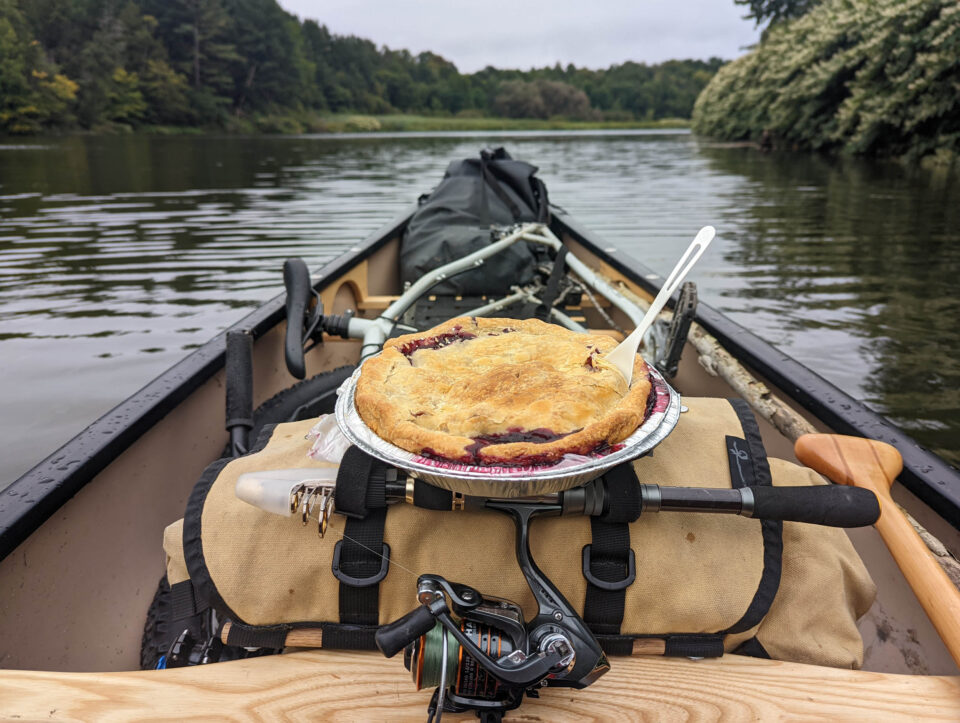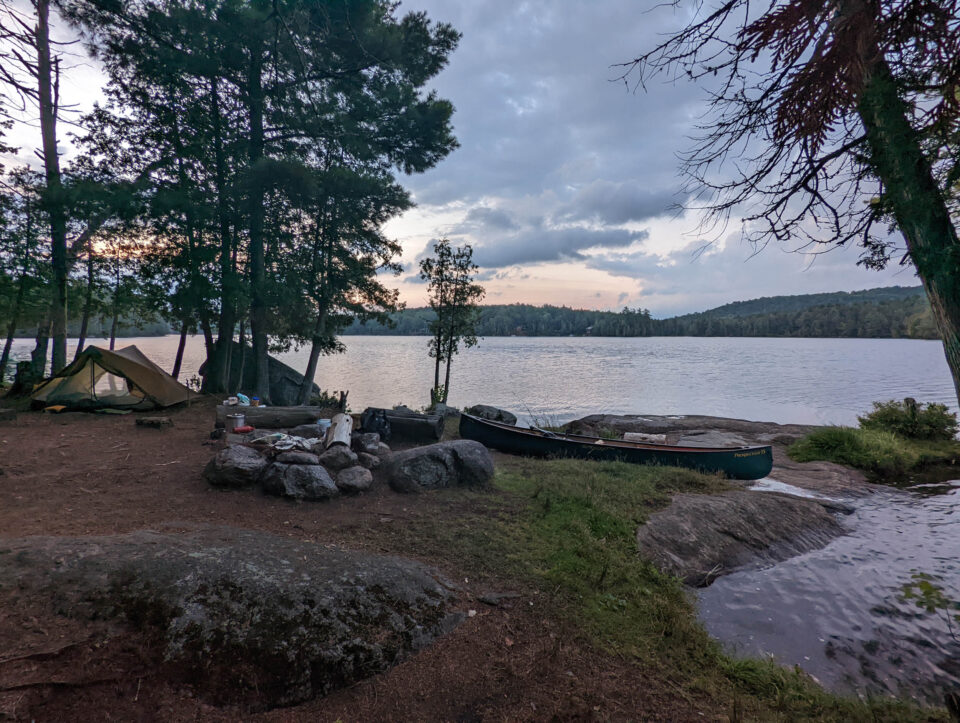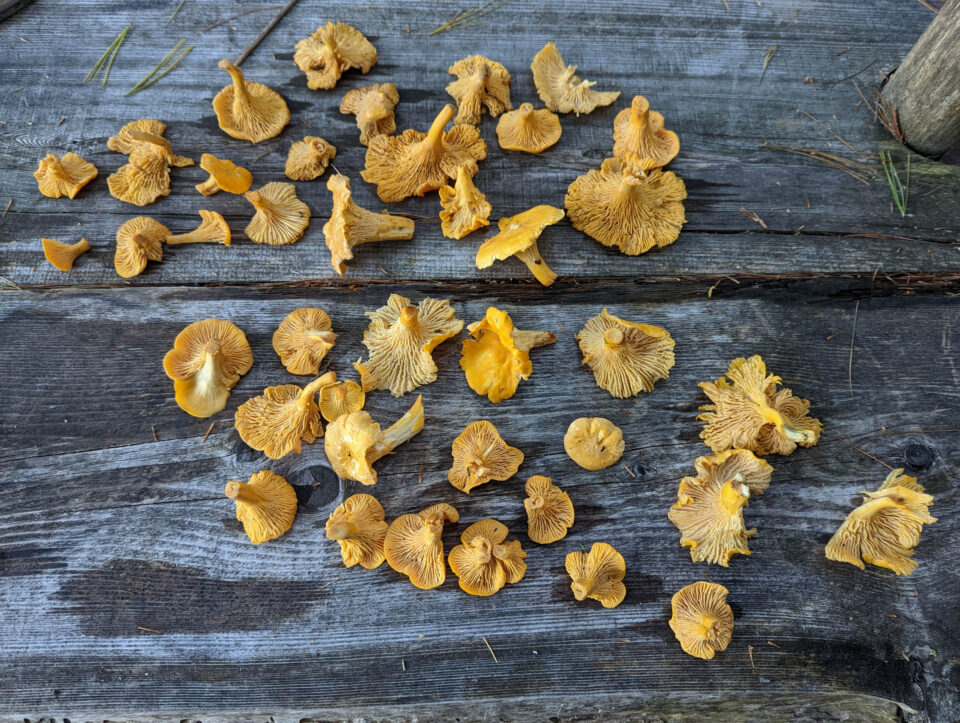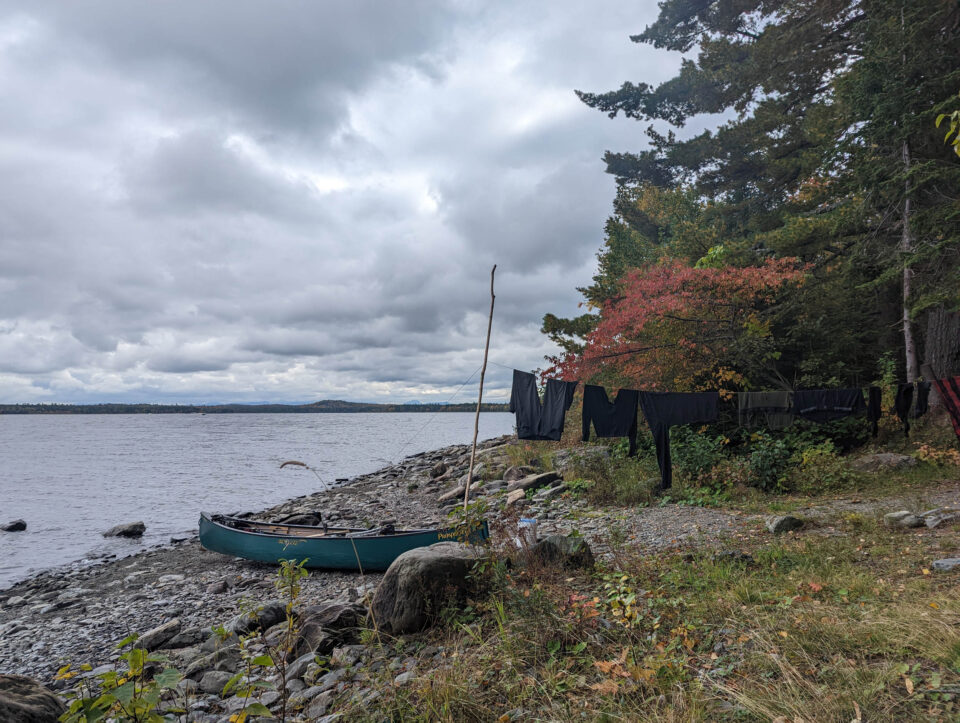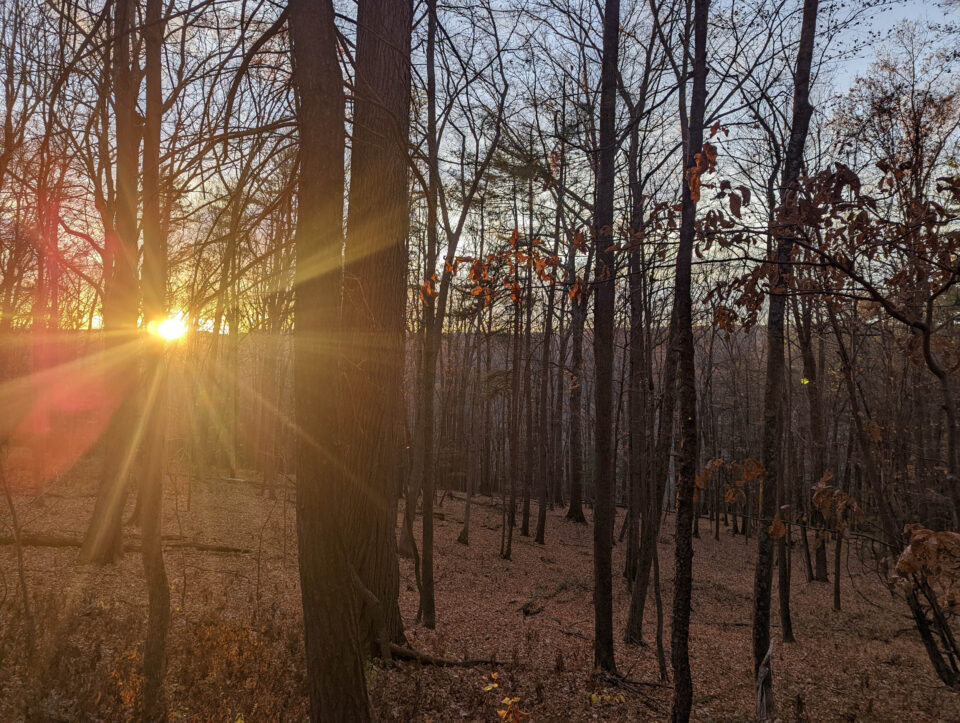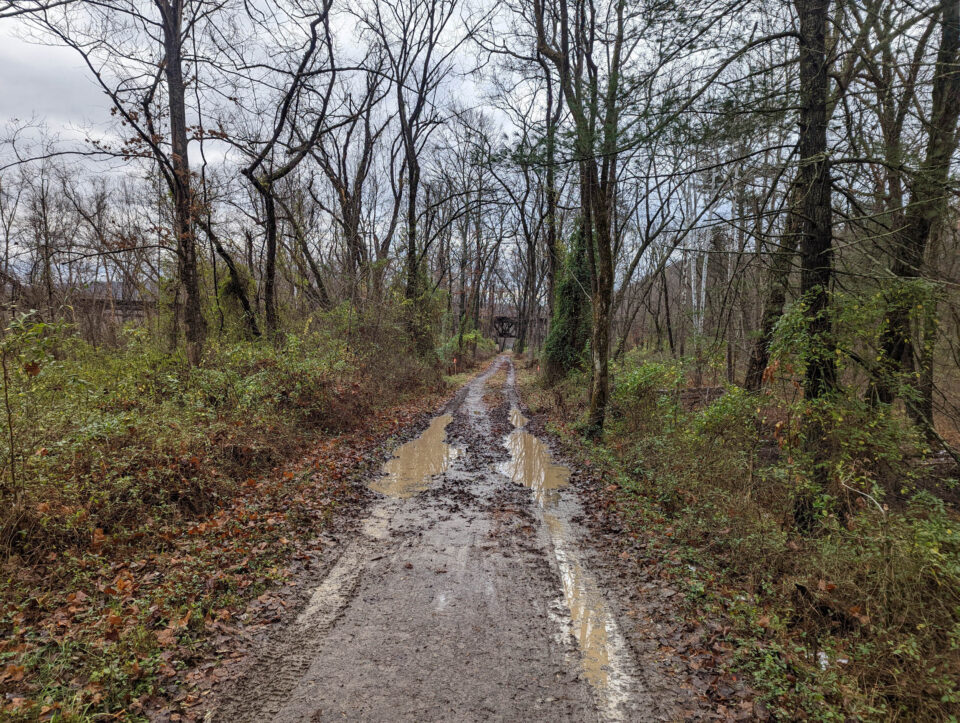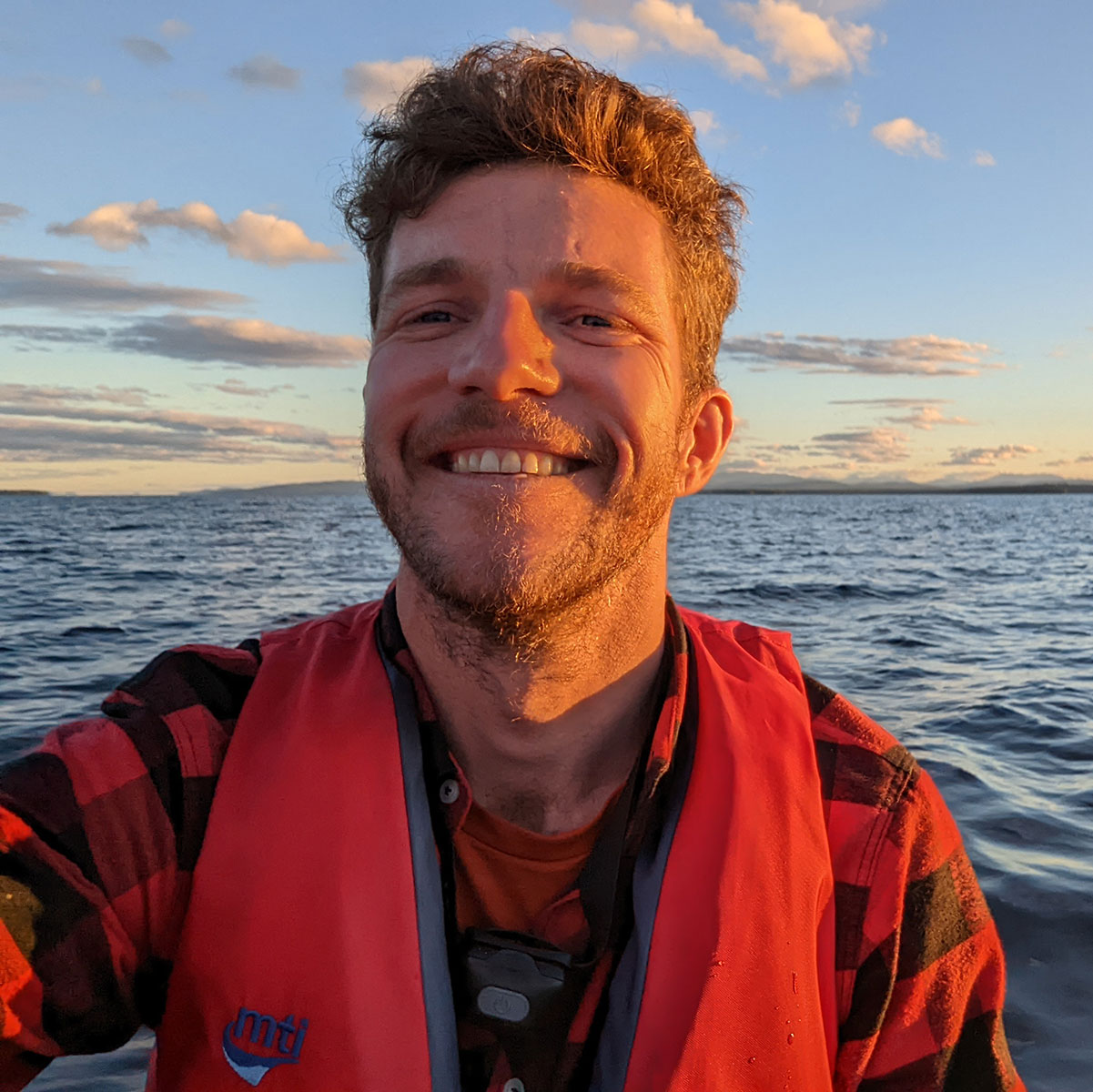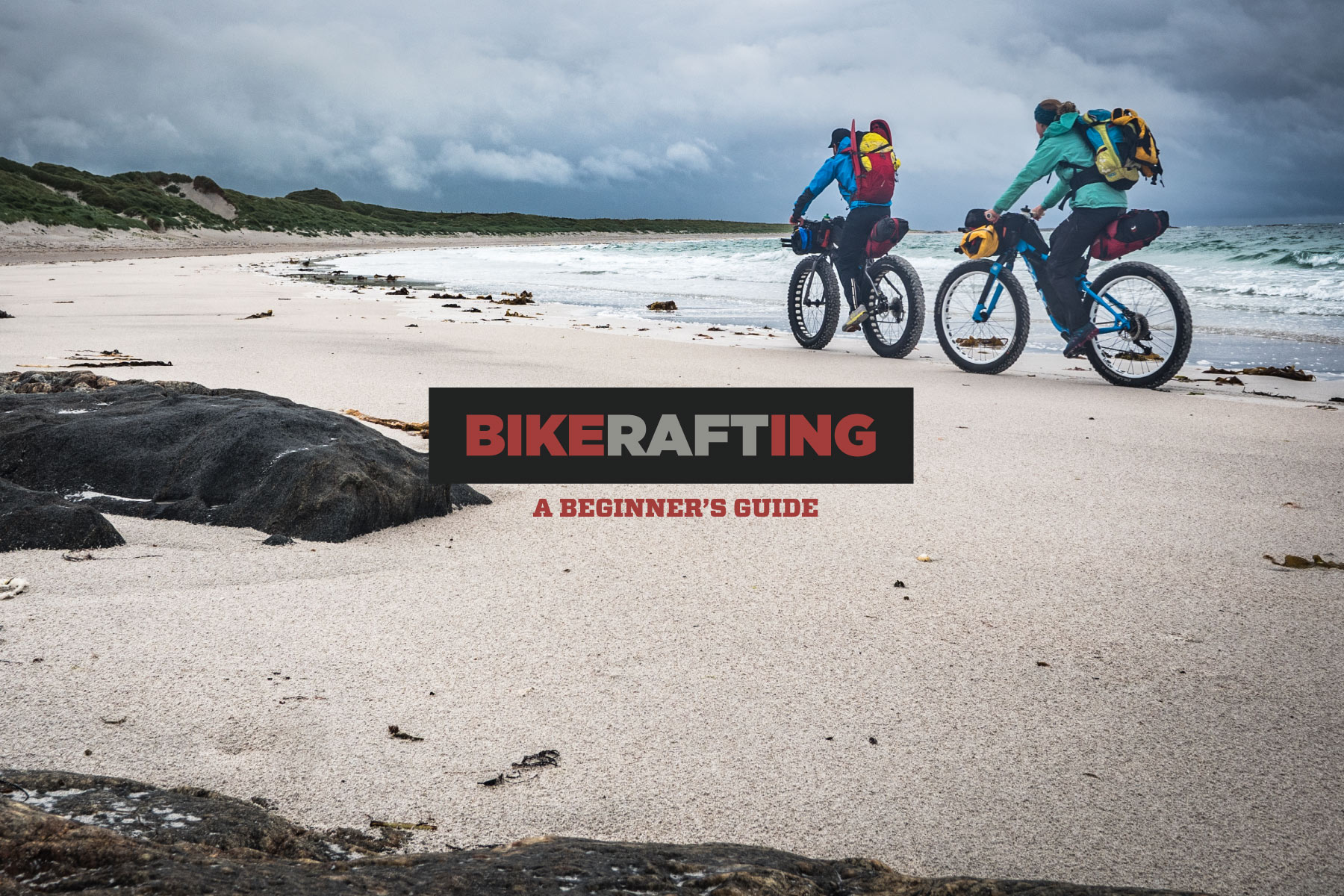Eastern Divide Trail and NFCT by Bikeanoe (Bike & Canoe)
Share This
Last fall, Micah Fay set out to pedal and paddle the Eastern Divide Trail and Northern Forest Canoe Trail (NFCT) by bike and canoe. In this two-in-one report, Micah reflects on the trip, shares his method for portaging the canoe by bike, and offers some perspective from the roads and waterways…
Words and photos by Micah Fay
We left West Philly a few hours later than we’d planned to. Doing a final audit of my gear took a while, and my friend who joined me for the first day didn’t mind the late start. He went to grab one last thing from his car as I paused in front of my house to take a photo of my loaded bike. He came back with a conch shell, leaned way back, and blew a few long ceremonious notes toward the sky to mark the beginning of the trip. Rituals often hit me harder than I expect them to, and the anxiety of planning last-minute details was replaced with calm, excitement for the trails and waterways ahead, and gratitude for being able to take a break from work to do something for myself.
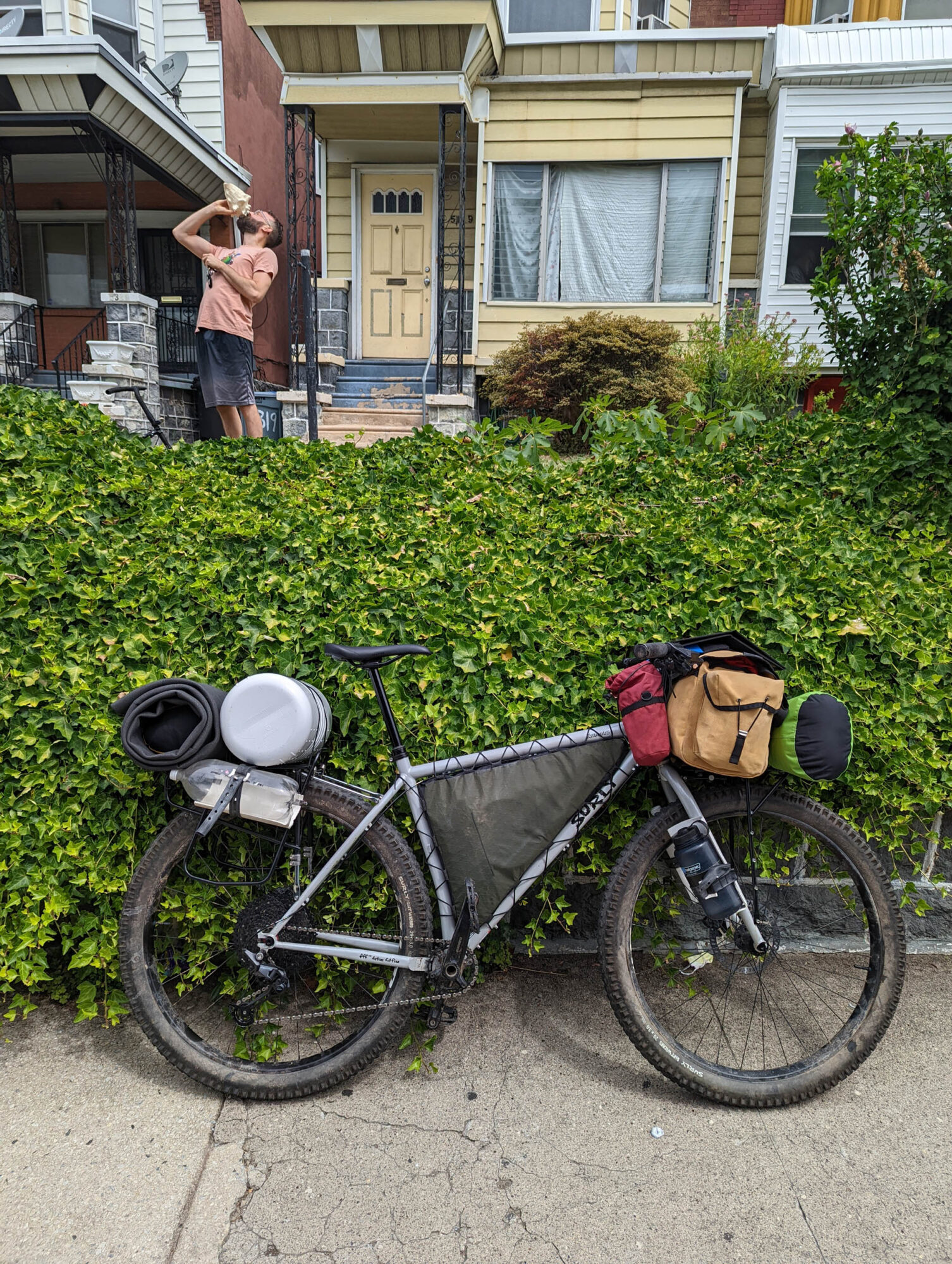
I’d been dreaming about paddling the Northern Forest Canoe Trail (NFCT) since I first heard about it. Cycling there on some rail trails and then back south along the newly created Eastern Divide Trail (EDT) mountain bike route seemed like the perfect way to deal with transportation to and from the NFCT, and a chance for me to finally try out bikepacking.
It was my first cycle tour of any kind, and I was looking forward to the simplicity of leaving for a wilderness adventure without having to get into a car. Riding through my neighborhood—not on our way to an adventure, but already on one—was freeing. We rode the Schuylkill River trail out of the city to Valley Forge Park that first night, and I rode it to its end in Hamburg, Pennsylvania, the following day. Having ridden on the Philadelphia sections my whole life, finally riding the whole trail felt like a significant achievement on its own. From Hamburg, I stitched together more rail trails and quiet country roads through Pennsylvania and New York all the way to Old Forge and the Adirondacks.
I had purchased a canoe, paddle, and life jacket over the phone from Mountainman Outfitters in Old Forge, which were waiting for me when I arrived. I grabbed a few other things, including a sun hat, a copy of the NFCT guidebook, an extra bear bag for food that wouldn’t fit in my bear can on the longer remote stretches, and a large dry bag that could fit all my gear instead of stringing together all my bike bags on every portage.
Once I gathered everything I’d need from the shops in Old Forge, I loaded my new canoe up with my gear, a celebratory amount of food, and my bike—which luckily fit inside with only minor disassembly—and started paddling up the Moose River and onto the Northern Forest Canoe Trail. It was August 24th.
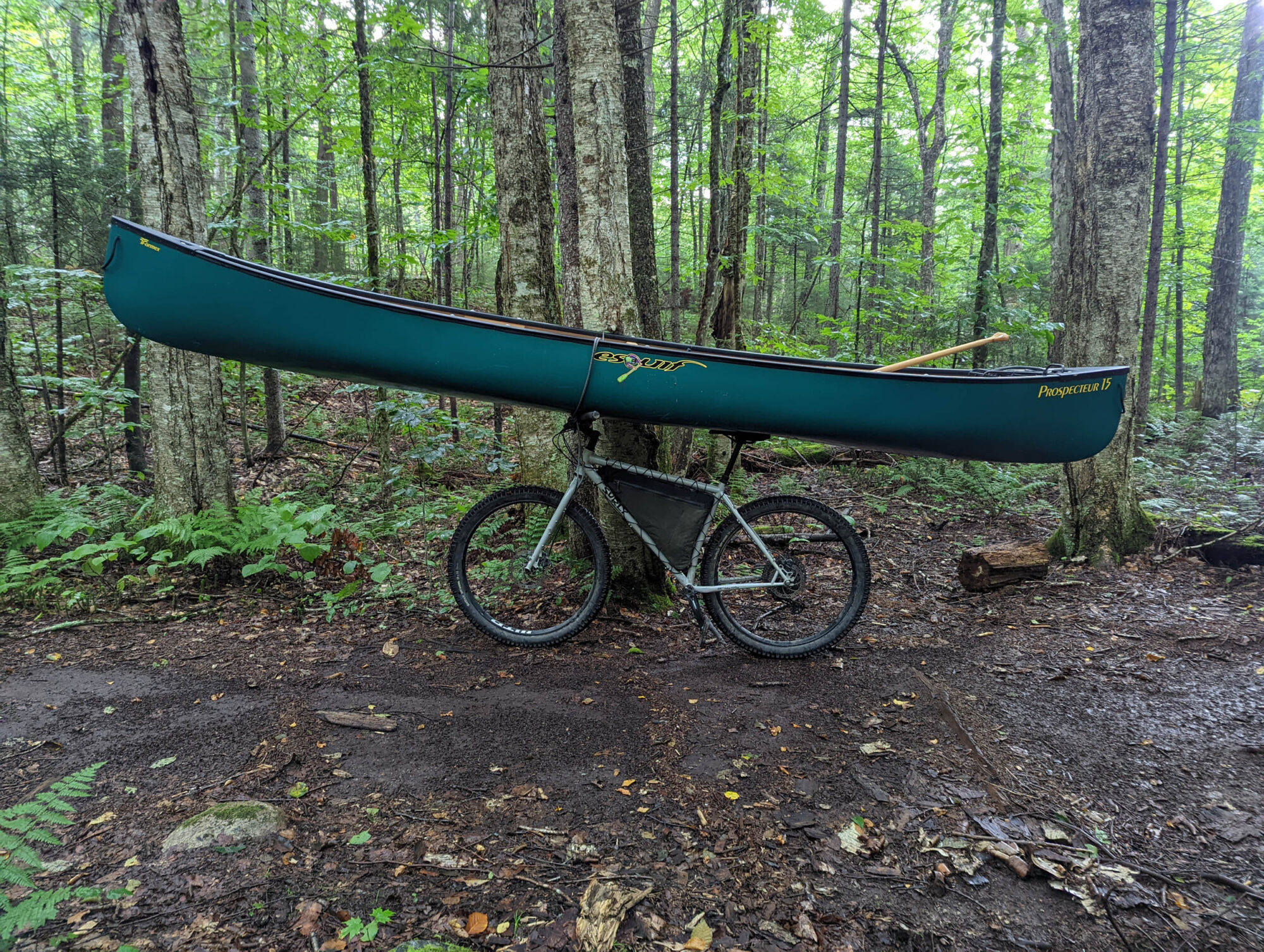
The first day of paddling also included the first portage and my first attempt at loading my canoe onto my bike. I had the idea that I could use my bike as portage wheels, with the canoe sitting upright on the handlebars and seat, but like pretty much everything else on this trip, I hadn’t had a chance to try it before I left. The 70 miles of portages would have been really slow if I had to do them all in multiple trips. Luckily, it worked great. Other than space in the boat, I think a bike is probably superior to the wheels built for the purpose. I was able to tackle a lot of trails that would have been impassable with two wheels side by side or less clearance below the boat.
Getting the canoe onto the bike is more of a trick than a feat of strength. You basically just stack the canoe on top of the bike with both of them laying on their sides on the ground, tie a loop of rope to each side of the handlebars and over the boat, and then lean the whole works up together. Here’s a clip of me loading it up at Union Falls Pond if you’re curious:
I don’t know if anyone had done a #bikeanoe portage before, but I hope it catches on. Many folks were asking me about it when I rolled through towns. They took photos and videos of me, gave me thumbs-ups, and shared often expletive-laden appreciation for my setup, all of which I enjoyed.
The Adirondacks were spectacular. Once past the Fulton Chain, the more dramatic peaks start to come into view across the expansive lakes and around the riverbends. The northern half of Long Lake and the subsequent section of the Raquette River are as remote as it gets in the ‘dacks, and the long sunny days paddling with the current and swimming in the still-warm water were amazing. I think I took a hundred videos of aquatic grasses swaying in the current with the sunlight reflecting off the water’s surface before I gave up on adequately capturing just how mesmerizing the scenes were.

One of the most memorable sections of the trip was crossing Lake Champlain. I got to the lake on a windy day with the forecast showing a short break in the wind overnight followed by four days of 10-mile-per-hour winds out of the south. That’s enough to make Champlain impassable in a canoe, and the wind is a lot scarier than the dark in a small boat on open water. So, I decided to cross the lake that night. I called a couple of friends while I waited for the wind to die down, partly just to catch up, but also so someone would know what I was about to do in case something went wrong. It ended up being one of the most beautiful and peaceful stretches of the whole trip.
I watched the sunset over the Adirondacks as the last of the motorboats went in for the night. The moon and stars came out and shone just bright enough to pop the most subtle silhouette of the mountains against the sky. The wind had stopped completely, and the stars reflected off the lake’s surface almost as clearly as they shone above. The whole scene was disorienting in the most beautiful way, and drifting in the lake felt closer and closer to drifting in the cosmos as exhaustion crept in on me. I made it to camp on North Hero at 1:30 a.m.
From Champlain, I headed upstream across Vermont, Quebec, and New Hampshire to Maine. It was actually the upstream sections that got me interested in the NFCT; the chance to pay homage to the history of our waterways by following Indigenous trade routes up and down stream—as all of our rivers were once traveled—drew me in. It also meant I’d have the chance to refresh my canoe poling skills. I had learned to pole a canoe from Master Maine Guide Ray Reitze when studying for previous adventures and was excited to shake off some of the rust.
Once you get the hang of it, poling can feel like an upstream or downstream dance. And while a good paddler needs to be able to read the rivers well to pass smoothly downstream, going upstream often requires that ability to make any progress at all. When it’s going right, you feel the pole bend slightly under your weight and snap you forward at the end of the stroke. It’s a real joy to try to stay in the back eddies when you can, whip into the current to pass rocks, and quickly tuck back into the next eddy in front of them. When it’s not going right, you start wondering how much faster it would be to just walk up the nearest road, a choice I strictly made for the safety of myself or my boat.
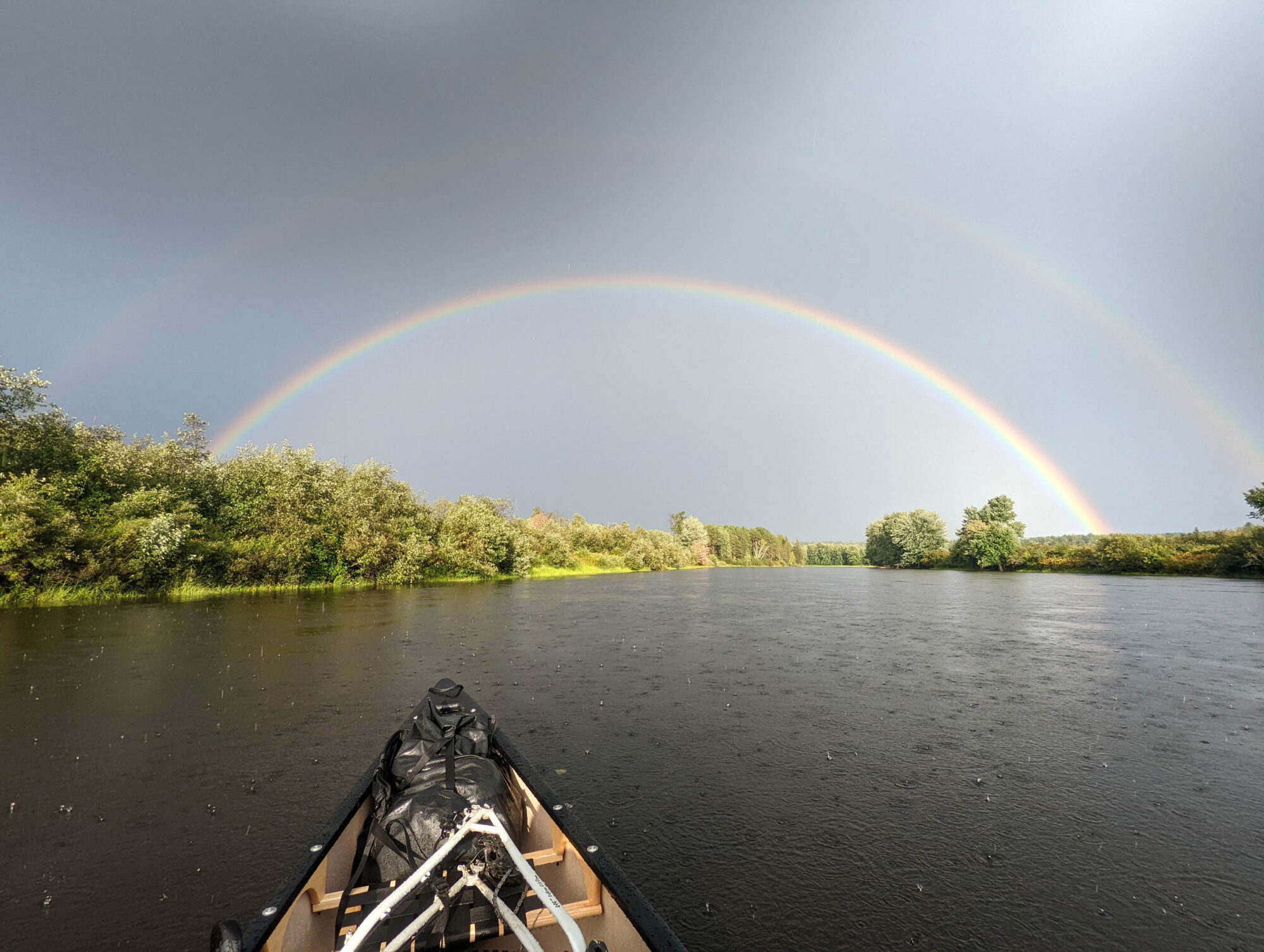
Once I got to Maine, a few days of heavy rain swelled the rivers up nicely for the way downstream. I hunkered down in the Halfway Hilton lean-to in Rangeley for one of those rainy days, which was glorious, and it was one of only a few layovers I took the whole trip. I chatted with a nice crew of Appalachian Trail hikers while I was there, which was really fun. I think we were jealous of each other: them for the solitude and water access of the NFCT and me for the camaraderie of having so many other folks on the same trip. After a couple nights of relaxing, stops at most of the restaurants in town, a grocery store rotisserie chicken, heaps of junk food, and some fresh fruits and vegetables, I was on my way down the Moose River and into the final stretch of the NFCT.
The remote sections of Maine are, of course, the cherry on top of the canoe trail. I didn’t run into many people during any part of my trip—no one seems to know that September and October are the best months to go camping in the northeast—but the Maine wilderness felt particularly endless, and I started feeling much more present as I got closer to the end. It was easy to get preoccupied with the logistics and physicality of the whole thing, especially when racing winter, but once the end was in sight, I started dreading it being over and savoring it even more.
The final Maine stretch is a good place to be present, and the leaves were close to the peak of their fall colors as I crossed over Moosehead Lake. I tried to soak in as much of it as I could and even let myself drift with the current for a few long stretches. If I could do the trip again, I would love to stay a night or two in every town and make sure to camp at least one night on every pond, river, lake, and stream. There’s a lot to take in out there, and I think I missed a good bit of it at my pace.
On my 40th birthday, I made it to Fort Kent on October 3 after 40 days of paddling. At 25 degrees, it was the coldest morning of the trip up to that point. The blue skies over the Saint John, colorful leaves, glistening frost, expansive rolling farmland, and steady current made for a wonderful final day on the water.
I mailed a box home with my dry bag, guidebook, and fishing gear, and donated my canoe to the Fort Kent adventure program at the University of Maine. After a couple nights of camping in the park in town and some gluttonous trips to the college cafeteria, I put the racks back on my bike and prepared for the second leg of my journey.
Riding the Eastern Divide Trail
The Eastern Divide Trail mountain bike route enters the US in Houlton, Maine, about 100 miles south of the terminus of the Northern Forest Canoe Trail. From there, you can follow it north to Cape Spear, Newfoundland, or south to Key West, Florida. It includes some chill gravel roads, some rowdy singletrack for a loaded bike, and everything in between. There’s also a paved road here and there to connect the unpaved sections.
I rode on a nice network of rail trails from Fort Kent to Houlton with only a few miles on pavement along the way, then headed south toward Key West. Getting back on the bike was equal parts thrilling and jarring. Bouncing and rattling over deeply rutted Maine forest roads and climbing up and skidding down loose gravel hills was quite a contrast from the quiet, steady days paddling a canoe.
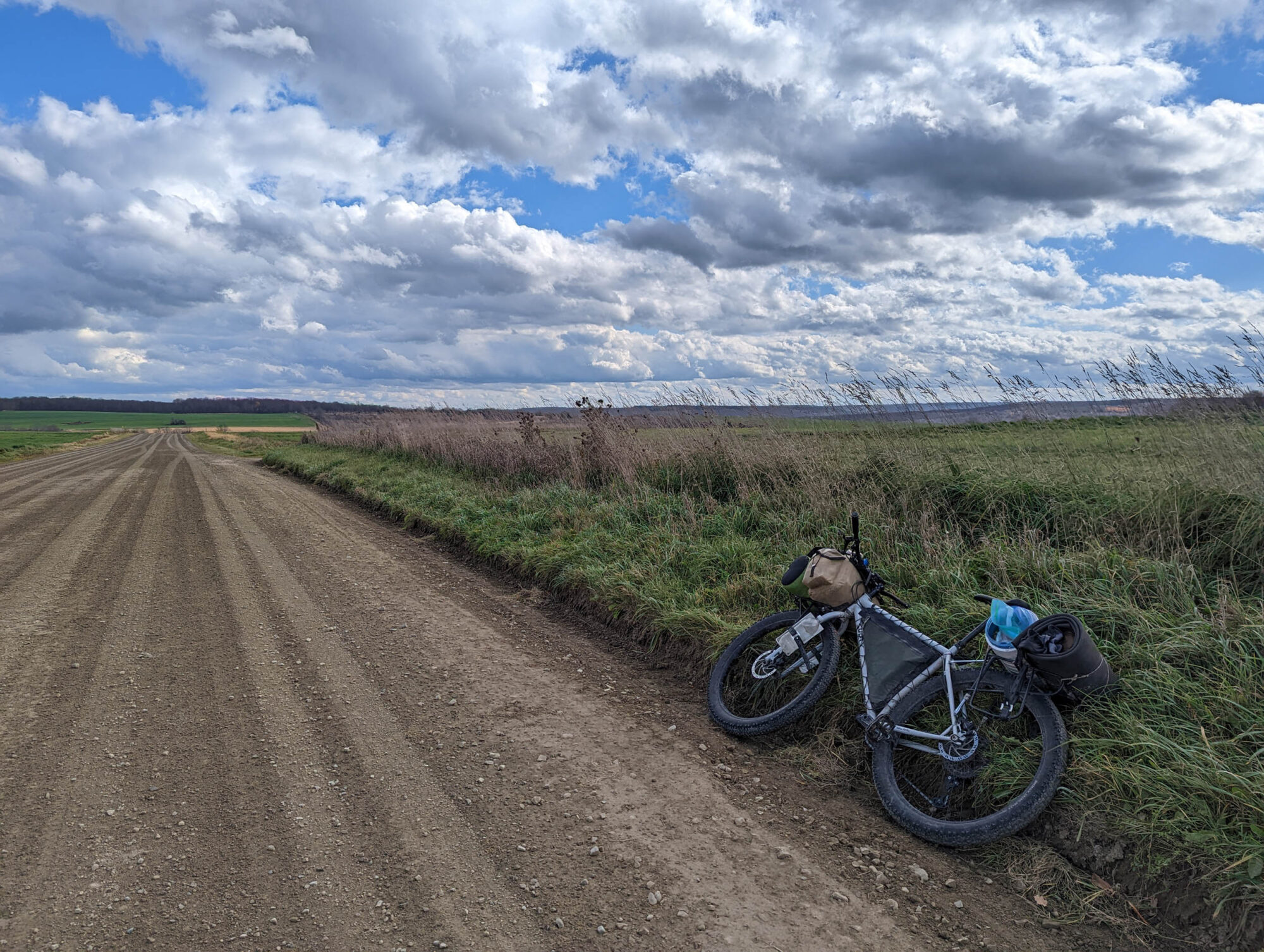
The EDT is brand new—the final sections of it were made public while I was on the NFCT—and that meant I was able to help scout some routes and add a few tips to the guide for future travelers, which was a highlight for me. One of those additions is the NFCT Halfway Hilton in Rangely. The EDT passes down the road behind it, and the folks at the NFCT and the Museum that owns the land are willing to allow bikepackers to use the lean-to as well. I took another rainy day layover there on my way south and was surprised how cozy it felt to stay in a familiar place after a couple months of constant movement. I hope bikepackers and paddlers cross paths there in the future!
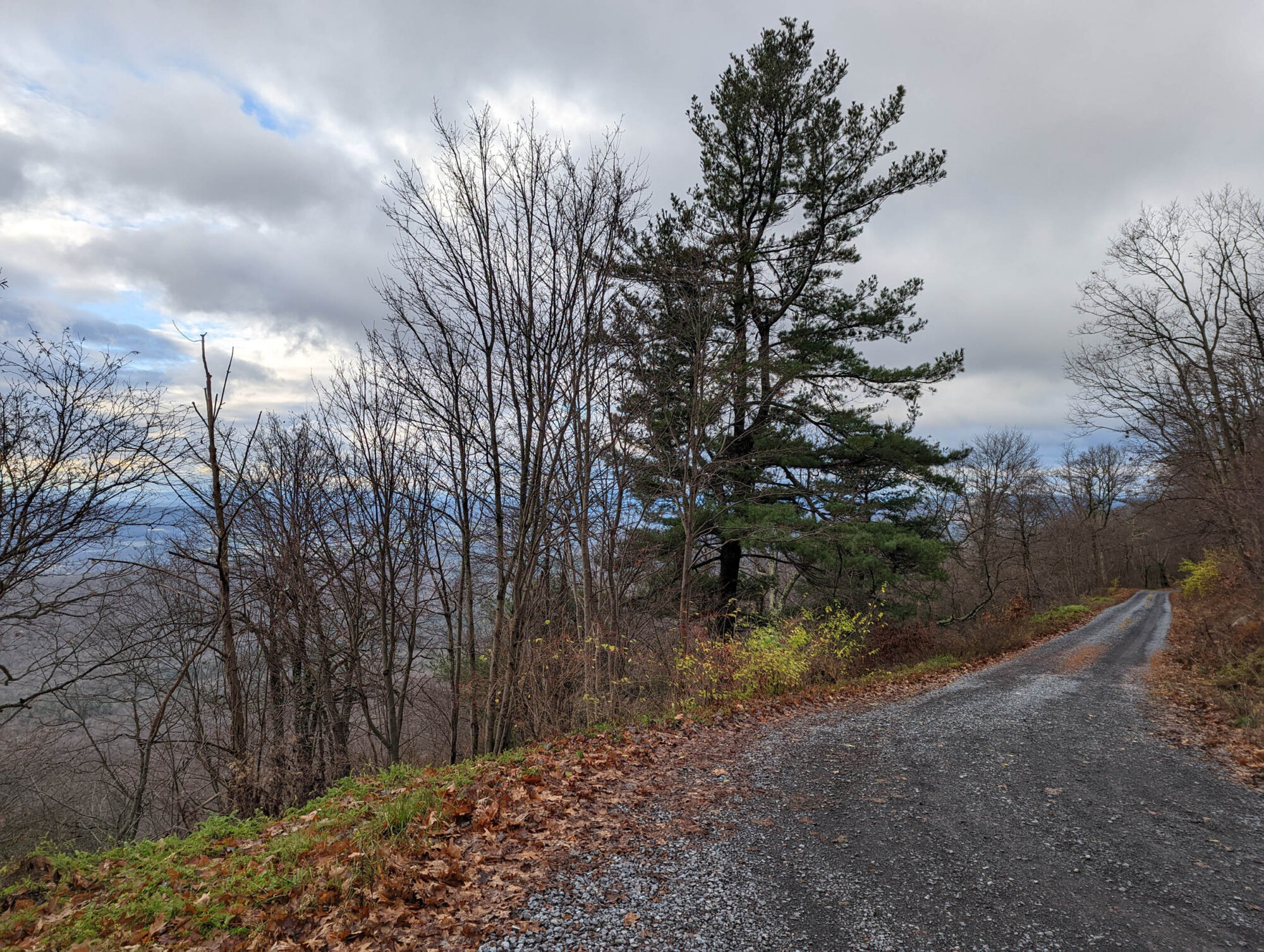
I crossed the NFCT several times on the EDT. It was a treat to catch views of some of the lakes and rivers I’d paddled from the ridges of the continental divide. They follow different paths for the most part, though, and I loved getting a fuller picture of the northeast by seeing it from both perspectives. The final crossing was near Old Forge, New York, where I’d made my first #bikanoe portage to Sixth Lake. I stopped there to take a photo and to soak up how far I’d traveled since I last passed it.
After dropping out of the Adirondacks and the steep climbs and descents that characterize the New England portion of the EDT, it heads west over the Finger Lakes, largely on the smooth and level Erie Canalway Trail. I loved the steep sections but appreciated the chill, historic Erie Canal section too. Clear skies meant I could just roll my sleeping pad out under the stars next to the trail once it got dark and start pedaling before it got light and trail traffic picked back up.
By the time I got around the last of the Finger Lakes and onto the Genesee Riverway Trail, the days were getting short, and the long nights reading on my kindle were feeling a bit monotonous. I had also started getting some nerve pain in my fingers while riding, a remnant of some old injuries that come back to haunt me occasionally. My cousin told me that your handlebar should be an inch above your seat for every 10 years you are over 30, so I got a stem extension in Canandaigua to see if it would help. It helped some, but the tingling didn’t go away completely. I started telling myself, “Well, I’ll finish this section and see if I’m still having fun.” I kept on having fun for a long time.
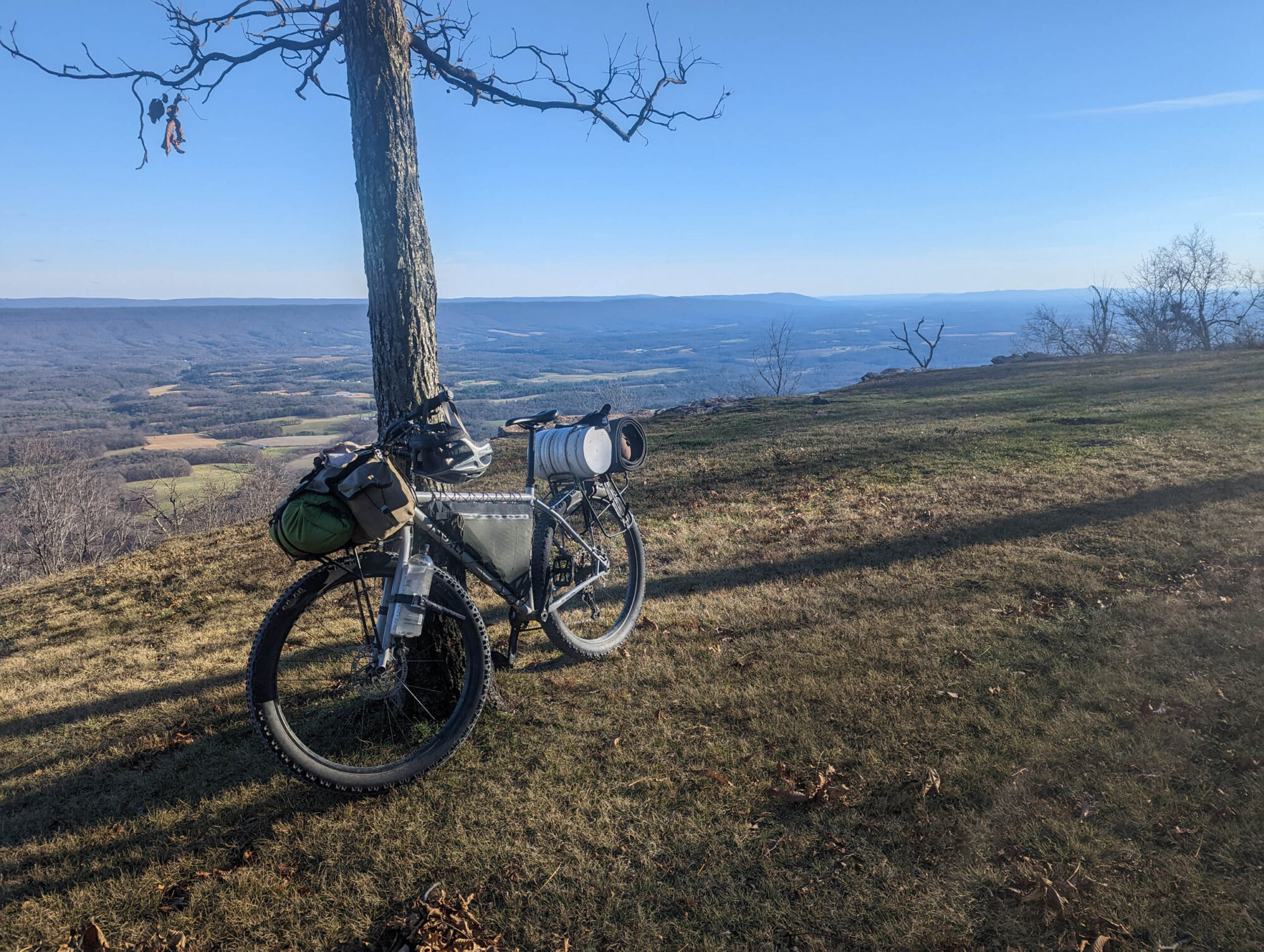
The stretch down through the Genesee Gorge in Letchworth State Park was breathtaking and included some of the more aggressive and fun singletrack of the trip. From there, the divide goes across a long series of rolling farmland hills through New York before dropping down into Pine Creek Gorge in Pennsylvania. Much of my home state’s mountains are dominated by long ridges and valleys, and the route has several long rides down the backbones of those ridges. It was well into November at this point, so I had clear views through the leafless trees on either side of the ridges, which made this somewhat more tame section of the Appalachian chain pretty memorable.
The Pennsylvania section ends with a ride through the abandoned turnpike tunnel—I recommend riding through it with lights off for maximum eeriness—before dropping into Maryland, where the route joins the C&O Trail. Seeing so many landscapes at a cycling pace was amazing, and being able to easily pop into a town for a morning at a cafe and then be in remote wilderness that night, without getting in a car, was as wonderful as I’d hoped it would be.
My brother Zach planned to meet me in Davis, West Virginia, a great mountain town we’d both spent time in, to hang out for a weekend before I continued south. We’d rented an Airbnb there for a few nights, and I ended up having to push hard through slushy roads and muddy trails to get there on schedule. The night before I got to Davis, I camped in the Dolly Sods, and the winter weather I had been staying just ahead of finally caught up to me.
It was November 17, and the temps dropped below 10 degrees. The wind was blowing at around 25 miles per hour, and six inches of fresh snow and ice coated the ground. I spent the night curled up in a ball, wearing all the clothing I had with me, and thought about what the next month would be like if the trails continued to be icy and muddy until I got to Georgia. I woke up to a gorgeous, crisp, bluebird morning like the day I got to Fort Kent, made my coffee and peanut butter raisin oatmeal from the inside of my tent, and broke camp.
The road around the perimeter of the plateau was covered in snow and ice, which groaned at the still-frigid temperatures as I rode along it. I stopped for a while at an overlook and watched the rays of the rising sun glisten in the icy branches of the trees from the edge of the plateau. Then, as I descended off the plateau toward Davis, and the wind picked back up, and it started to rain and snow again, I decided to catch a ride back to Philly with my brother.
Related Content
Make sure to dig into these related articles for more info...
Please keep the conversation civil, constructive, and inclusive, or your comment will be removed.






